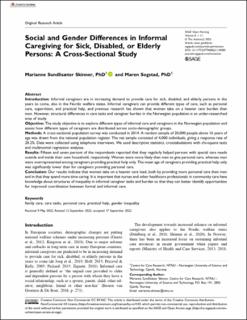| dc.contributor.author | Skinner, Marianne Sundlisæter | |
| dc.contributor.author | Sogstad, Maren Kristine Raknes | |
| dc.date.accessioned | 2023-03-09T12:06:03Z | |
| dc.date.available | 2023-03-09T12:06:03Z | |
| dc.date.created | 2022-09-13T21:36:10Z | |
| dc.date.issued | 2022 | |
| dc.identifier.citation | Sage Open Nursing. 2022, 8 . | en_US |
| dc.identifier.issn | 2377-9608 | |
| dc.identifier.uri | https://hdl.handle.net/11250/3057351 | |
| dc.description.abstract | Introduction: Informal caregivers are in increasing demand to provide care for sick, disabled and elderly persons in the years to come, also in the Nordic welfare states. Informal caregivers can provide different types of care, such as personal care, supervision and practical help, and previous research has shown that women take on a heavier care burden than men. However, structural differences in care tasks and caregiver burden in the Norwegian population is an under-researched area of study. Objective: The study objective is to explore different types of informal care and caregivers in the Norwegian population and assess how different types of caregivers are distributed across socio-demographic groups. Methods: A cross-sectional population survey was conducted in 2014. A random sample of 20,000 people above 16 years of age was drawn from the national population register. The net sample consisted of 4,000 individuals, giving a response rate of 20.2 percent. Data were collected using telephone interviews. We used descriptive statistics, crosstabulations with chi square tests and multinomial regression analyses. Results: Fifteen and seven percent of the respondents reported that they regularly helped persons with special care needs outside and inside their own household, respectively. Women were more likely than men to give personal care, whereas men were overrepresented among caregivers providing practical help only. The mean age of caregivers providing practical help only was significantly lower than for caregivers providing personal care. Conclusion: Our results indicate that women take on a heavier care load, both by providing more personal care then men and in that they spend more time caring. It is important that nurses and other healthcare professionals in community care have knowledge about structures of inequality in informal caregiver tasks and burden so that they can better identify opportunities for improved coordination between formal and informal care. | en_US |
| dc.description.abstract | Social and Gender Differences in Informal Caregiving for Sick, Disabled, or Elderly Persons: A Cross-Sectional Study | en_US |
| dc.language.iso | eng | en_US |
| dc.publisher | SAGE | en_US |
| dc.rights | Navngivelse-Ikkekommersiell 4.0 Internasjonal | * |
| dc.rights.uri | http://creativecommons.org/licenses/by-nc/4.0/deed.no | * |
| dc.title | Social and Gender Differences in Informal Caregiving for Sick, Disabled, or Elderly Persons: A Cross-Sectional Study | en_US |
| dc.title.alternative | Social and Gender Differences in Informal Caregiving for Sick, Disabled, or Elderly Persons: A Cross-Sectional Study | en_US |
| dc.type | Peer reviewed | en_US |
| dc.type | Journal article | en_US |
| dc.description.version | publishedVersion | en_US |
| dc.source.pagenumber | 11 | en_US |
| dc.source.volume | 8 | en_US |
| dc.source.journal | Sage Open Nursing | en_US |
| dc.identifier.doi | 10.1177/23779608221130585 | |
| dc.identifier.cristin | 2051438 | |
| dc.relation.project | Norges forskningsråd: 182481 | en_US |
| dc.relation.project | Norges forskningsråd: 262858 | en_US |
| cristin.ispublished | true | |
| cristin.fulltext | original | |
| cristin.qualitycode | 1 | |

